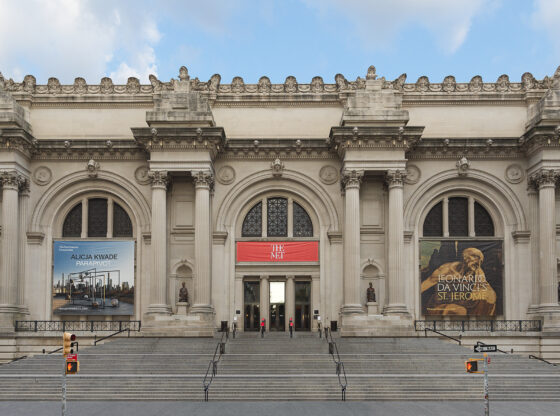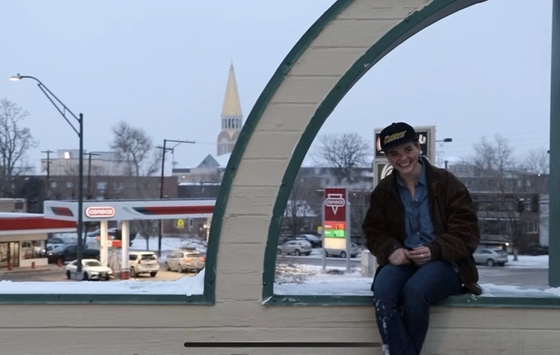In an exhibit titled Catalyst, put together completely by the upper-level Professional Practice class taught by faculty member Sarah Gjertson, twelve pieces of student art, ranging from photography to drawing, painting and sculpture, are all exhibited in the foyer of Shwayder Art Building.
The term catalyst is typically defined as a person or thing that precipitates an event or change. According to an explanation posted on the wall of the exhibit, the works in the exhibition were compiled in the juried process by which ones had a visual ‘catalyst’, whether metaphorical or literal.
Tingyu Lin, senior Bachelor of Fine Arts student from Taiwan, who helped juror the exhibit and also help with public relations, explained that the Professional Practice class is all seniors, mostly Bachelor of Fine Arts majors, who must take this sequence course to become familiar with many of the finer points of being a professional artist, including how to create personal websites, giving an artist’s talk to the public and the logistics that go into curating an exhibit like Catalyst, along with different methods that will later help them when submitting their own work to exhibits as well.
“As soon as the quarter started everyone in the class started to take on their job. Some were installing, some were public relations and we also had a jury committee,” said Lin.
Students in the Professional Practice class were allowed to submit pieces, but were not able to participate in the final jury committee. According to Lin, none of these pieces ended up being chosen for the final exhibit.
Lin explained that the jury committee got together and decided through multiple rounds of selection which pieces they felt fit the theme of general “catalyst” or visible change, which included not only considering the piece itself but also the artist’s statement that went along with it. She also noted that with the size and shape of the Shwayder foyer, space limitation was one of the main issues in constructing the exhibit. There is one sculpture, called “Identity” by senior BFA student Matthew Swisher from Los Gatos, Calif. and the rest are film or digital photography, paintings or drawings that could easily fit the wall space. The sculpture is made of steel and galvanized wire, with the wire appearing to explode out from the backing in what can be described as a visual catalyst.
“There were a lot of good submissions, but we had to accommodate for space too. We figured on which ones fit best by itself, but also together as a whole,” said Ling.
Despite the relative homogeneity with chosen mediums, the pieces are still distinct and detailed. When compared with the juried alumni exhibit that is displayed right inside of the Myhren Gallery in Shwayder, the quality standard is equal to that of the more experienced artists displayed nearby.
Some of the pieces seem to harken towards personal identity changes, such as Brian Napier’s “Weekend Warrior” drawing, where wild animals burst forth from a conservative business suit, created with alcohol marker on paper. The title and apparent message of this piece seems to wink at the change in normal behavior between the mundane weekdays, versus more anticipated weekends or time off. Similar to this drawing, each piece added its own nuanced meaning to the overall theme, the “catalyst” being more obvious in some than in others.
One of the artists whose work is exhibited, Hunter Roberts, a junior music major in Jazz and Commercial Music from Parker, found out about the Catalyst exhibit from a class he was taking with faculty member Deborah Howard, called Experiences in Visual Art. He said that although he had been painting his piece, “Paper Crane,” for a few months before the exhibit, the deadline for submissions really pushed him to finish it. Roberts explained how the theme of “catalyst” fit into his own work:
“It’s hard to say specifically where the inspiration came from, but thunderclouds over the Colorado plains tend to blow my mind, so they are very prominent in the piece. Also origami is very interesting to me. An old friend from high school used to make hundreds of origami pieces to hand out to students, so he was inspiring for this piece,” said Roberts.
Roberts also commented on how he hopes his piece will affect it’s viewers.
“I hope that the piece inspired change in people’s view of everyday things they see. We accept everything that we see as a title or label defining what that thing may be, but if you look deeper and try to understand it for yourself, the world can better come alive,” said Roberts.
Lin also said she hoped that after viewing the exhibit, each person will leave considering what their inspirations and muses in life are.
“Some pieces will have a stronger impact for different people than others will. So I want people to leave thinking about what inspires them, what their own catalyst is,” said Lin.











